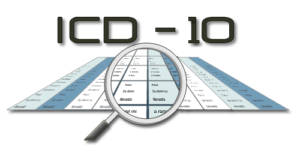“Train people well enough so they can leave… treat them well enough so they don’t want to.”
-Sir Richard Branson business magnate, investor and philanthropist.
 For a printable copy of this tent poster click: [LINK]
For a printable copy of this tent poster click: [LINK]

“Train people well enough so they can leave… treat them well enough so they don’t want to.”
-Sir Richard Branson business magnate, investor and philanthropist.
 For a printable copy of this tent poster click: [LINK]
For a printable copy of this tent poster click: [LINK]

We know all too well how keeping abreast of all the changes in the insurance world can sometimes be overwhelming for your practice so we wanted to simply help you out by sharing some recent information regarding ICD-10 codes.
ChiroCode Institute recently published the changes to ICD-10 Codes that are going into effect October 1st. While there are thousands of code changes, we have listed below the codes most relevant to chiropractors. To download a printable copy of this list click here [ICD-10-Changes-Oct-2016]
ICD-10 Reference:
Gwilliam, Evan M, DC MBA BS CPC CCPC NCICS CPC-I CCCPC MCS-P CPMA, ChiroCode Institute
If you have any questions regarding these changes Petty, Michel and Associates would be glad to help guide you in the right direction. Please email to services@pmaworks.com or call us at 414-332-4511. We are here to help!
Spring is finally with us and the flowers and trees are beginning to bloom up here in the northern Midwest.
What is amazing to me is that I start seeing flowers pop up where I must have planted them, or someone did, a few years past. Pop, pop… a daffodil here and tulip there, some lilies and Astors and I don’t know what! Who planted these?
Growing, developing, and sustaining a chiropractic practice corresponds in many ways to the laws of nature or the laws of a farm. What makes these plants bloom are many things – the warmer weather, some biological clock, water, of course, and sunlight. Maybe some organic fertilizer now and then.
They also have something else. Something that has allowed them to weather the snow and the cold and the storms so that they are here now… waving to us in the still cool of early spring.
A few years ago I wrote an article about roots and patient retention. I know… seems like an odd comparison, but it’s not really. The thing with roots is that they are not seen and not always appreciated. I made the analogy of having a good root system in your practice – which would be the loyalty your patients have with you. I discussed methods to create and improve this relationship in the article, Chiropractic Root System
I just reviewed the article and realized that I omitted a key component in creating great patient loyalty, patient retention, and patient referrals. It is actually pretty obvious and something I see in the offices I visit.
But first, let me include here some survey information from the 2010 Customer Experience Impact Report (CEI) for North America by Rightnow Technologies* that will help make my point.(My underlines and bolds.)
“WORD OF MOUTH IS MIGHTIER THAN THE SWORD
Consumers aren’t only demonstrating their power with their wallets, but they are influencing those around them as well. Whether a consumer has a positive or negative experience, their friends, family, colleagues and networks are sure to hear about it and what they are saying carries weight.
Customer service is the most influential thing a company can do to increase customer advocacy.
55% (up from 53% in 2009) of consumers recommend a company because of its customer service, compared to products at 49% and price at 42%.
But those who have issues are also voicing their opinions and it can have a severe impact on a company’s reputation and ultimately bottom line.
Imagine the result of 66% of a company’s frustrated customers on a mission to discourage others from buying from that company. Consumers aren’t just complaining when something goes wrong, they are determined to have their presence felt by the company at fault:
WHAT MAKES A GREAT EXPERIENCE?
Consumer expectations continue to rise, but their requests are reasonable and within reach. Put simply, consumers want easily accessible, accurate information to make well informed buying decisions. And they want to be respected, treated well, and have their issues resolved in a timely fashion.
Of those who decided to stop doing business with an organization,
Finally, it all comes down to this:
“WHEN YOU HAVE A BAD EXPERIENCE, YOU DON’T GO BACK.
This has been a mainstay result from the Customer Experience Impact Report (CEI). The fifth annual report cited that 82% of consumers have stopped doing business with a company as a result of a negative experience.”
So, it is not “time” or “money” as the primary reason patients drop out of care. Simply put – their experience was not AWEsome enough!
This is why Google Reviews or any legitimate review has such a strong impact on referrals. It is Word of Mouth marketing.
But how do you create it? Is there some fancy form or new procedure? A Dx code perhaps? Well, there are forms and procedures, but these are 20th on the list. The first 19 have to do with excellent communication and service. Communication that is genuine and caring.
In the article about increasing patient retention and the root system, I do give a few ideas on how to improve your service and, in turn, retention and referrals. But… so apparent to me now, I left something out!
Time and time again, where I see an office struggling to get new patients… I also notice a low morale office.
The low morale may not be obvious. In fact, studies show that the majority of employees (70%) are really not engaged in their work, but simply go through the motions.** This is so common that blasé, disinterested employees or time crunched, rote professionals seem to be the cultural norm.
But I routinely interview staff and work with office managers and hear THEIR side of the story, at least part of it.
If a team member is disgruntled, disaffected, discouraged, or in any way “dis”, the quality of service they provide to the patient will be affected. Let’s put it another way: if your team is anything BUT happy and cheerful and truly looking forward to their day with YOU and the patients, you have a problem.
There are many studies that show the cause and effect of employee morale and customer service. But I have personally observed it many times myself.
The offices with the HIGHEST patient retention and most patient referrals are the ones where the support team and doctor, or doctors, have a great relationship with each other. In fact, aside from the now and then stress points, you could say that they truly like and admire each other and respect each other’s good work.
Adding to this, these offices also have dedicated a continuous effort for training and education. Webinars, seminars, internal trainings, coaching (Hi there!), and books – one of the most overlooked training tool.
Now, what hampers all this is the stress of running a business. Doctors like to “doctor.” Chiropractic, or whatever good care you provide, does not fail. Doctors can always improve, and should, but it is usually the support organization that finally jams up on itself like railroad cars banging into each other, or even jackknifing.
As many of you know, I am working on a practice CEO training program. After a certain point of practice growth, it becomes difficult to continue to grow the business as a doctor. There is just too much to do. This is why you now need to learn and implement some fast flow procedures as a CEO, procedures which are very different from a doctor.
The CEO is a leader. John Maxwell*** lists five levels of leadership. At the first level people will follow you because they have to. At the second level they follow you because they actually like you! You have a relationship with them. At the third level they see that you get real results for the organization. Fourth… you are helping them become leaders! The last level is many orders of magnitude above the others… they follow you because of what you represent. Think of Martin Luther King, Gandhi, etc.
As this happens, a lighthearted sense of pride and confidence will grow in your office. Synergy will improve. Staff will be engaged with the patients more and the patients themselves will also become part of the synergy.
Your practice will become well-nourished and strong, like perennial plants and trees that flower each spring.
Your patients will keep coming back.
# # #
Learn to look after your staff first — and the rest will follow.Customer service can make or break a business. If you treat your staff well, they will be happy. Happy staff are proud staff, and proud staff deliver excellent customer service, which drives business success. – Sir Richard Branson (Virgin Companies)
=====================
Chiropractic Root System and Patient Retention
*Rightnow Technologies. Download the report here. http://media.stellaservice.com/public/pdf/Customer_Experience_Impact_North_America.pdf
**http://www.gallup.com/poll/181289/majority-employees-not-engaged-despite-gains-2014.aspx
*** John Maxwell, The 5 Levels of Leadership
“The more you are motivated by love, The more fearless & free your action will be.”
~Dalai Lama
Printable version of the tent poster email services@pmaworks.com